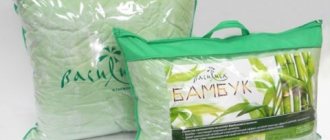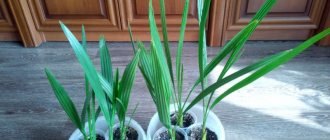- September 22, 2019
- Houseplants
- Maria Vetoshkina
Flower growers love to grow bamboo, because it is easy to care for and you can create a variety of unique compositions from it. At the same time, bamboo is planted differently, and each method has its own advantages. That is why information on how to replant bamboo at home will be of interest to many.
Transfer rules
Bamboo shoots are best germinated in water. They should be transplanted into the ground when the roots reach 4-5 cm. Bamboo cuttings with small roots do not take root well, and roots that are too long are easy to damage during planting. It is necessary to remove the cuttings from the water before planting.
You can use any rooting agent; you just need to sprinkle it on the damp roots. A pot of soil must be prepared in advance; a hole in the soil must be made slightly larger than the rhizome.
The soil should be added in small portions until the pot is filled. The soil should not be compacted too much to avoid damaging the young roots.
After planting, the cuttings are watered and, if necessary, soil is added. In order for the young shoot to take root better, it can be sprayed with water in the first week.
Types and varieties of bamboo
Among the many types, several are the most popular:
- Sasa is grown in Japanese gardens; there are dwarf and long-growing varieties, the height of the stems is from 25 cm to 2.5 meters. The leaves of Kuril saz are up to 13 cm long and reach 25 mm wide. Saza Nebulosa resembles a palm tree, the Vichi variety has a golden hue.
- Fargesia or Chinese bamboo is a group of medium-sized plants. The length of the sheet plates is up to 10 cm, width is up to 15 mm.
Up to 40 types of fargesia have been sectioned for home cultivation and winter gardens:
- The brilliant one tolerates frosts well, overwinters painlessly in open ground, and when the stems become lignified, they acquire a pleasant dark brown color;
- The New Collection is valued for its exterior: a dark cherry trunk with a purple tint contrasts with lush greenery;
- McClue grows up to 3.5 meters high, the variety is used for linear plantings, camouflaging fences, trellises;
- Eisenach, Great Wall - varieties of bamboo with small thin dark green leaves, these varieties are used to create hedges;
- Simba, Jumbo, Bimbo are low-growing varieties for indoor growing.
Phyllostachys is a tall type of bamboo with short internodes, flattened or grooved colored stems:
- black (stems begin to darken after two years of growth);
- with golden grooves and purple thickenings;
- light blue, exotic color begins to appear when the shoot becomes stiff in the second year of life, this heat-loving variety is used in landscape design;
- green, not all varieties of bamboo change the color of the stem during growth;
- yellow-brown, this contrast traditional for bamboo is often combined with a different shade of internodes.
Pleioblastus are dwarf varieties, among which there are variegated ones. The shrub is suitable for home growing.
Selecting a site and preparing for transplantation
Before transplanting, you need to prepare everything you need. To do this you will need: a planting container, soil, drainage material, and a means for rooting the flower.
The choice of location also needs to be approached carefully. Bamboo came to us from tropical forests, where the climate is humid and warm. Therefore, a bamboo indoor plant will do well in a warm and well-lit corner. He only needs diffused light; light partial shade is also suitable. The most comfortable temperature is considered to be from 20 to 25 degrees. In the room where bamboo grows, the air should not stagnate.
Mr. Summer Resident informs: ways to grow bamboo at home
At home, the plant develops well in water. It is enough to change it once a week. Indoor varieties are unpretentious, they quickly gain weight and produce layering. It is allowed to add growth stimulants and fertilizers to the water (1/3 of the recommended amount so that there is no stress for the sprout). In indoor conditions or in a winter garden when grown in soil, bamboo stems reach a height of 2 meters. In a short time, flower growers create real tropical thickets. It is important to feed the crop in a timely manner and not let the water stagnate.
Plastic is not recommended for growing; it is better to choose glass or stainless steel containers of large volume; it is acceptable to use tall jugs. The vessels are placed near a window or light source. The plant gives good growth under a phytolamp. Water for bamboo shoots is first left to stand in an open container so that the chlorine evaporates.
Filtered or tap water is not suitable for the plant. The plant reacts very well to melt water.
Soil and pot for the plant
In what soil should I plant bamboo? This plant belongs to the dracaena family, so for planting it, a ready-made soil mixture specially designed for dracaenas is best suited. It can be purchased at a specialty store.
The container for planting bamboo can be anything, the main thing is that it must meet two requirements:
- The diameter of the pot should be approximately twice the size of the plant's rhizome.
- The pot must have drainage holes.
The plant will look very impressive in a beautiful vase if its stems are additionally tied with a bright ribbon.
Caring for indoor bamboo
Caring for the Bamboo of Happiness comes down to regular watering and spraying: the plant does not tolerate drought well. In winter, weekly watering is sufficient.
The surprisingly unpretentious plant does not need feeding, however, if the leaves begin to turn yellow, then this is a danger signal: the plant does not have enough nutrition. Therefore, to prevent diseases in winter and summer, bamboo is fed with mineral and/or organic fertilizers.
How to replant bamboo in an apartment
Bamboo is an unpretentious plant; it grows well in water, in soil, and in hydrogel. But he will feel best in the ground.
The process of planting bamboo in a pot is as follows:
- For planting, you need to choose healthy, richly green seedlings that have living, undamaged roots.
- It is better to choose a pot deep enough and spacious enough so that the roots have room to grow. Particular attention should be paid to the drainage holes to ensure the outflow of water from the container.
- The soil, as mentioned above, must be taken ready-made. Expanded clay or small pebbles are suitable for drainage.
- Water for irrigation should be melted or settled.
The drainage layer should be at least 3 cm; moistened soil is placed on it in small portions and a hole is immediately made. The cuttings are taken out of the water, a preparation for root growth should be sprinkled on the roots and a little of this preparation should be added to the hole itself.
The roots are sprinkled with earth, compacted a little, and the pot is completely filled with soil. Water thoroughly so that water flows out through the drainage holes. Water must be removed from the pan so that it does not stagnate.
Instructions for planting in open ground
Bamboo should be planted in the ground as seedlings
So, it will take root faster. Planting should be done in spring or summer. The sooner this is done, the stronger it will become by the winter.
For successful wintering, the roots must be covered for the first year . To prevent young shoots from dying, you need to install protection from the wind. Cold gusts of which will destroy the plant.
Landing
Planting bamboo
Planting is carried out in several stages:
- The lump of earth with roots should be well saturated with water. If this is not done, it will not flow well even with abundant watering. To do this, the pot with the seedling is lowered into a container filled with water. Must be kept in the shade. This procedure will protect the roots from damage when it comes time to pull.
- A hole is dug larger than a coma with roots.
- The soil is fertilized. Humus and humus are added to the pit.
- When choosing running bamboo, a root barrier is installed.
- Place the seedling in the middle of the hole, fill the void with soil and compact it.
- Water the young plant generously.
You cannot fertilize bamboo with fresh manure and chicken droppings. They can burn the roots.
Bamboo running barrier
The roots of running bamboo varieties grow quickly. They spread at a depth of 20 cm, but can come to the surface. A limiter is placed on the site before planting. It is dug to a depth of one and a half meters, with the upper edge protruding 10 cm from the ground.
Barrier device
To limit the spread of the plant you can use:
- Slate
- Metal
- Barrier film
- Root barrier
To prevent the roots from falling through the limiter, you need to dig in at an angle. The top edge of the plant should be located at a greater distance from the trunk. The edges overlap each other.
If the root has bypassed the barrier, you can cut off the unnecessary part. Be sure to pull the piece out of the ground. Otherwise, it will spread further, filling the entire space with young bamboo shoots.
Watering
During the first months after planting, you need to ensure that the soil does not dry out. Water generously. This will speed up the rooting process. But you cannot allow water to stagnate, otherwise the roots will begin to rot.
Bamboo does not tolerate drought
If there is a lack of moisture, the leaves will begin to curl into a tube. The plant quickly dies from drying out. After the bamboo begins to dry, watering is reduced to 3 times a week.
If there is a lack of moisture, as with all cereals, the roots will begin to move deeper. The plant will extract moisture from the depths of the earth. The frequency of watering must be adjusted depending on natural precipitation. In rainy years, watering is reduced.
Mulching
In autumn it is recommended to mulch. Mulch consists of pine bark, wood chips, hay, straw or peat.
Mulching the soil
The layer should be no more than 5 cm . A thick layer may attract rodents, which will damage the bamboo. This layer will ensure stable soil temperature and moisture.
Trimming
The plant is pruned once a year. It should be done in the spring. Remove dry, frozen and unsightly shoots.
Bamboo trimming
If the thickets are dense, thinning is carried out. This procedure will allow the sun's rays to penetrate deeper. Bamboo straws have knots. If you cut above the bud, a new shoot will grow.
Top dressing
Fertilizing is carried out 2 times a year: in spring and autumn. To do this, nitrogen, phosphate and potassium fertilizers are mixed. In spring the ratio should be 4:3:2, in autumn 2:4:4.
When choosing organic fertilizers, they should be applied once a month in spring and summer.
In this case, in autumn and winter, bamboo takes a break from feeding.
Wintering
The upper part of the plant freezes in the first year of growth at -17 degrees, and dies at -20. If weather forecasters predict a cold winter without snow, then young shoots need to be bent and covered. The best shelter is spruce branches.
With each winter the plant becomes stronger and more resistant to frost.
When the trunk and shoots die, the roots are preserved. They are warmer in the ground. There is a chance that they will produce new growth in the spring.
Reproduction
There are 2 ways to grow bamboo:
- From seeds
- Vegetatively
Let's look at them in detail.
Seed propagation
Bamboo seeds
The difficulty of the seed method lies in the rare flowering. The positive side is that bamboo grown this way will be less sick. Its life cycle will be approximately equal to the cycle of the parent plant.
Seed preparation consists of several stages:
- They are dried in the sun for 2 hours
- Soak the planting material in water for 10 - 12 hours. Water is drained no earlier than 20 minutes before sowing
While the seeds are soaking, you need to prepare the substrate:
- 8 parts garden soil, top layer
- 1 part wood shavings
- 1 part wood ash
The mixture must be sifted and the container filled for planting. It should be loose. The seeds are deepened by 5 mm and covered with soil on top.
Seedlings are sprayed 2 times a day. The soil must be moist. The first shoots will appear in 20 - 25 days.
They are planted in separate pots after 3 months. During this period, seedlings will begin to produce new shoots. The plant is fragile and must be handled carefully.
The watering mode changes once. It is better to do it in the evening. It is recommended to keep the young plant indoors for the first winter. They are planted in the ground when the trunk grows 50 cm.
Vegetative propagation
The plant can be divided using this method at the age of three. You need to dig up the roots and separate the individual shoots. They must have up to three processes or nodes. And they must also have roots.
Bamboo cuttings
They are planted in a container. The shoots need to be watered once a day and kept in the shade. Transplantation into open ground is carried out in the spring. The plant is kept indoors for the first winter.
Possible problems
The above describes in detail how to replant bamboo, but after replanting the following problems may arise:
- The tips of the leaves dry out. Dry air or lack of heat is to blame for this.
- The leaves begin to turn yellow. If the leaves turn yellow slowly and infrequently, then this can be considered a natural process. If the leaves turn yellow constantly, this indicates a lack of nutrition; the plant needs to be fed.
- The leaves are curling up. This may be due to low temperature.
- Spots appear on the leaves: yellow-brown or dry. They can be caused by direct sunlight.
Using bamboo
Bamboo plays not only a decorative role
The plant is used quite widely:
- Young shoots are eaten as a vegetable. How crops are grown in Italy.
- The trunks are used as building materials.
- Bamboo is split and its fiber is used to create wicker items.
- The seeds are similar to oats and are also eaten.
- Used to make canes and umbrella handles.
- They make hats.
- Mats and sushi sticks are made from bamboo.
- The Thais used trunks - straws for water supply.
- Furniture is made from bamboo.
Lighting, humidity and temperature
Proper lighting is important for any plant. Bamboo, like other dracaenas, loves bright rooms, but direct sunlight will not benefit the plant. Direct sun may cause burns on the leaves. The flower will feel good in diffused sunlight. It will grow in partial shade, but insufficient lighting inhibits growth, and in this case the leaves may turn pale.
Bamboo is a tropical plant, so dry air is unacceptable for it. To humidify the air around the plant, you can place containers of water nearby, or use a special humidifier. The flower will also appreciate daily spraying.
Homemade bamboo loves warmth very much. In an ordinary apartment he will be quite comfortable, you just need to make sure that the air temperature does not drop below 20 degrees. The room where the plant is located can, and even should, be ventilated, but bamboo does not like drafts.
Thus, if you follow the conditions of keeping the plant, then planting bamboo, as described above, will not be difficult, because the plant will be healthy and strong.
Growing in open ground
Before planting bamboo, you need to evaluate the conditions for the plant's growth. This is done according to five main criteria:
- Variety
- Lighting
- windiness
- Temperature
- The soil
When choosing a variety, you need to clearly understand for what purposes it will be planted. Here its height and the shape of the leaves will be important. Some species look good alone, others need to be planted in groups.
It is important to analyze the temperature of the climate zone. There are varieties that can withstand frosts down to -28 degrees, and some will die at -15. Otherwise, the plant will die at the first frost, all efforts will be in vain.
Bamboo is not fussy. Despite this fact, it receives nutrition through the root system from the soil.
Therefore, the more nutritious it is, the better it will grow and develop. If the soil is poor, it needs to be enriched with fertilizer. Dense soil will slow down growth, but such soil freezes less easily. In the cold season, this feature will save the roots from freezing.
Many varieties of bamboo love sunlight. There are also shade-tolerant varieties. It grows faster and develops better in the sun. In winter, it depletes the plant. In the dry climate of the planting region, it is better to choose a place in partial shade.
Bamboo does not tolerate wind. Therefore, before planting a plant, it is important to come up with a protective barrier against it.
Plant pests and diseases
A healthy flower is practically not affected by diseases and pests. The latter include spider mites and mealybugs.
The first entangles the leaves with a cobweb. Spraying with Aktara helps combat it.
Mealybug appears as white lumps in the leaf axils. These lumps need to be removed and then treated with the Actellik insecticide.
The following diseases can be noted:
- Dark spots on the leaves are a fungal disease. It is necessary to treat the plant with a fungicide and ventilate the room more often.
- Slow growth - the plant lacks minerals. You need to feed it with a complex product.
- The leaves become dark and soft - the temperature in the room is too low, it needs to be increased.
Features of care in winter
- In winter, the air in a heated room is drier, and in order for the plant to tolerate this more easily, watering is reduced.
- Due to the dry air, it is recommended to keep bamboo away from heating appliances.
- Hypothermia also has a bad effect on the well-being of the “lucky bamboo”, so you should move it from the window sills, and when ventilating the room, protect it from drafts.
- In prolonged cloudy weather, it will not be superfluous to additionally illuminate the plant with fluorescent lamps. Especially if the leaves drooped and began to fall off, and the trunk turned yellow.
Adviсe
Some useful recommendations for better propagation and care of indoor bamboo.
The first thing to remember is not to expose the pot to the sun. Hot scorching rays are detrimental to dracaena, leading to loss of decorativeness, burns and damage to leaves.
Cold air and drafts should also be avoided when cleaning. If bamboo is regularly exposed to the wind, its leaves will turn yellow and the plant may even die.
Sometimes brown or yellowish spots appear on the leaves. This is a sign that the bamboo needs watering.
We learned how indoor bamboo reproduces. The simplest method is cuttings: using this method, even a novice gardener can cope with plant propagation. Well, our advice will help you carry out this procedure more competently.
A little about the plant
Indoor bamboo or Dracaena Sandera is a flower that has a bare stem and several leaves at the top. The trunk of the plant can be either straight or bizarrely curved. The bamboo varieties are usually found in bright green varieties, but sometimes grow with straw-yellow stems. Interestingly, indoor bamboo darkens when exposed to bright sun for a long time.
This plant not only decorates the interior, but also brings good luck - this is exactly what the ancient Chinese science of Feng Shui believes. Those who believe in omens and adhere to home planning according to Feng Shui, definitely try to acquire a Sander dracaena.
Reproduction by knees
This method is not often used in indoor floriculture, however, it is quite working and effective. Typically the method is used when an old plant dies or is too old.
The knees refer to the segments into which the bamboo stems are divided. In those places where the knees thicken, the flower can theoretically grow roots. For propagation, choose a high-quality healthy segment without damage or rot.
The knee is cut off and lowered into water. After the roots appear, the segment is buried in the soil, watered, and cared for. Thus, it is possible to give a second life to even very old or severely damaged indoor bamboo.
Photo
In the photo below you can see what composition can be created from bamboo with proper care:
Myths and beliefs
It is not known for certain who was the first to call Dracaena Sander the Bamboo of Happiness, and it doesn’t matter: the plant brings joy to the house and that’s enough. According to the Chinese philosophy of Feng Shui, bamboo attracts wealth and health into the home.
The number of stems also matters:
- Three stems will give you peace of mind.
- Five - will attract money.
- Seven - will ensure health.
- Twenty is happiness in love and family life.
- Twenty-one - all the blessings combined.
However, Lucky bamboo is not bamboo at all, so what do Chinese signs have to do with it?
But in fact, it doesn’t really matter whether this is an invention of cunning marketers or the legend has a basis: a thought, as we know, is material and all good things will definitely come true!
Watering rules
Many beginners believe that bamboo is a drought-resistant plant and does not need to be watered. Friends, this is a mistaken opinion. The ornamental plant loves water very much, and a deficiency will not allow it to take root in a new place. In order for bamboo to acclimatize to new conditions, follow these rules:
- Water the plant after planting in the ground as often as possible for 3-6 months.
- Fill the plant in the pot with 5 cm of water once every 10 days.
- To retain moisture, use mulch, this is ideal for those who forget to water.
- Touch the soil with your hand, if it is dry, water it.
- Drain excess water from the pan; excessive waterlogging damages the root system and it begins to rot.
- Watch the bamboo; if the leaves are curled, it means it needs watering; if they turn yellow, reduce the quantity and rate.
- Use only purified or settled water; in the water pipe it contains chlorine, this is death for the plant.
Author's note
Natalia Papanova
Blog author
For irrigation, use melt water. Fill a plastic bottle with regular tap water and place it in the freezer.
Watch a video about home care for Dracaena Sandera:
Getting plants from sticks
How to grow bamboo at home from such material? Very often, florists use bamboo sticks to arrange beautiful bouquets. Flowers fade very quickly, but decorative elements can be used to create a plant. Experts believe that you can get a full-fledged dracaena from sticks. They should be placed in a vase with water and wait until the roots appear.
Next, young plants can be planted in the ground or left in vases with water for further cultivation. The first method is more correct. Thanks to it, you can get a full-fledged plant that will grow well for a long time in your home.











